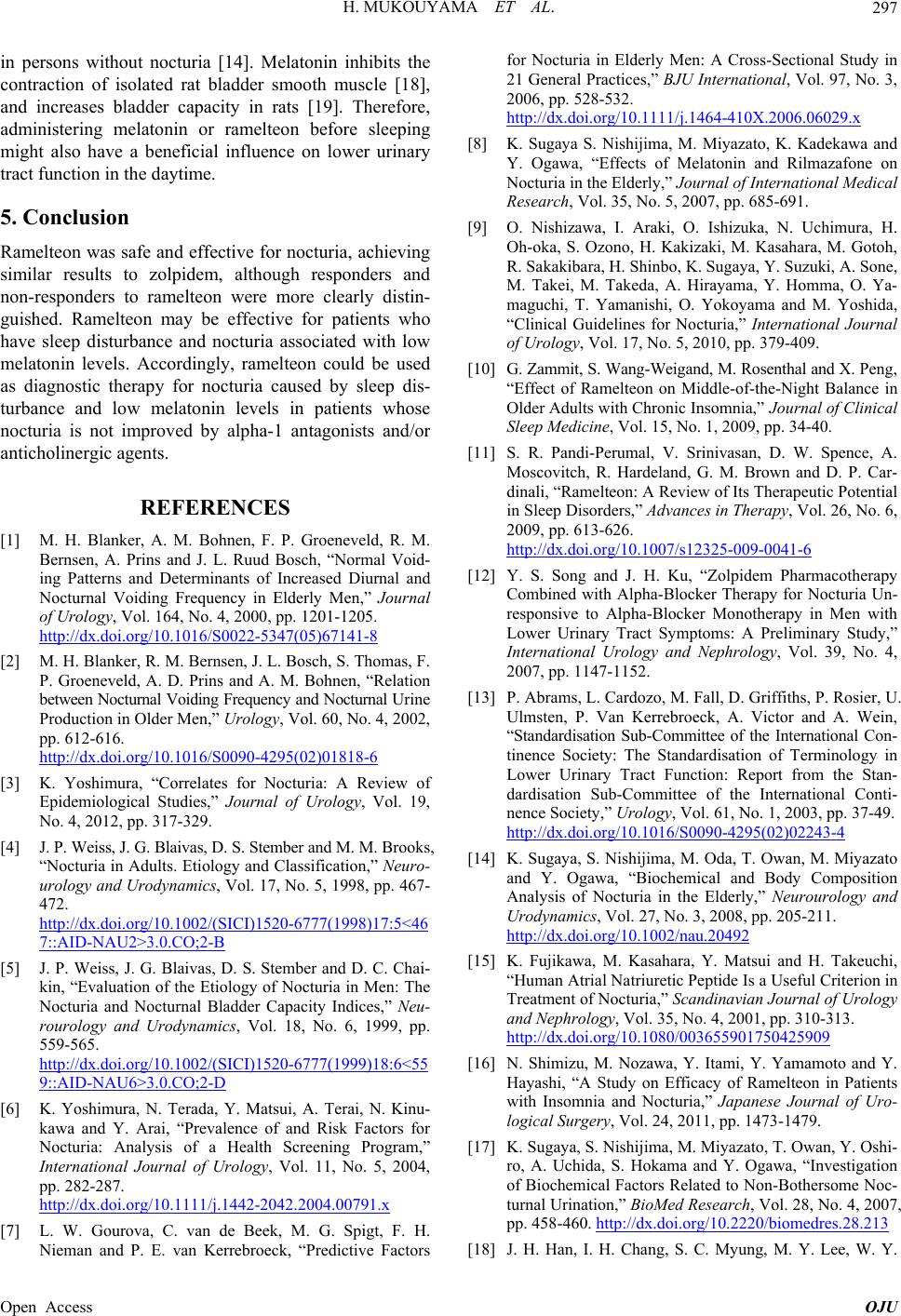
H. MUKOUYAMA ET AL. 297
in persons without nocturia [14]. Melatonin inhibits the
contraction of isolated rat bladder smooth muscle [18],
and increases bladder capacity in rats [19]. Therefore,
administering melatonin or ramelteon before sleeping
might also have a beneficial influence on lower urinary
tract function in the daytime.
5. Conclusion
Ramelteon was safe and effective for nocturia, achieving
similar results to zolpidem, although responders and
non-responders to ramelteon were more clearly distin-
guished. Ramelteon may be effective for patients who
have sleep disturbance and nocturia associated with low
melatonin levels. Accordingly, ramelteon could be used
as diagnostic therapy for nocturia caused by sleep dis-
turbance and low melatonin levels in patients whose
nocturia is not improved by alpha-1 antagonists and/or
anticholinergic agents.
REFERENCES
[1] M. H. Blanker, A. M. Bohnen, F. P. Groeneveld, R. M.
Bernsen, A. Prins and J. L. Ruud Bosch, “Normal Void-
ing Patterns and Determinants of Increased Diurnal and
Nocturnal Voiding Frequency in Elderly Men,” Journal
of Urology, Vol. 164, No. 4, 2000, pp. 1201-1205.
http://dx.doi.org/10.1016/S0022-5347(05)67141-8
[2] M. H. Blanker, R. M. Bernsen, J. L. Bosch, S. Thomas, F.
P. Groeneveld, A. D. Prins and A. M. Bohnen, “Relation
between Noc turnal Voiding Freque ncy and Nocturnal U ri ne
Production in Older Men,” Urology, Vol. 60, No. 4, 2002,
pp. 612-616.
http://dx.doi.org/10.1016/S0090-4295(02)01818-6
[3] K. Yoshimura, “Correlates for Nocturia: A Review of
Epidemiological Studies,” Journal of Urology, Vol. 19,
No. 4, 2012, pp. 317-329.
[4] J. P. Weiss, J. G. Blaivas, D. S. Stember and M. M. Brooks,
“Nocturia in Adults. Etiology and Classification,” Neuro-
urology and Urodynamics, Vol. 17, No. 5, 1998, pp. 467-
472.
http://dx.doi.org/10.1002/(SICI)1520-6777(1998)17:5<46
7::AID-NAU2>3.0.CO;2-B
[5] J. P. Weiss, J. G. Blaivas, D. S. Stember and D. C. Chai-
kin, “Evaluation of the Etiology of Nocturia in Men: The
Nocturia and Nocturnal Bladder Capacity Indices,” Neu-
rourology and Urodynamics, Vol. 18, No. 6, 1999, pp.
559-565.
http://dx.doi.org/10.1002/(SICI)1520-6777(1999)18:6<55
9::AID-NAU6>3.0.CO;2-D
[6] K. Yoshimura, N. Terada, Y. Matsui, A. Terai, N. Kinu-
kawa and Y. Arai, “Prevalence of and Risk Factors for
Nocturia: Analysis of a Health Screening Program,”
International Journal of Urology, Vol. 11, No. 5, 2004,
pp. 282-287.
http://dx.doi.org/10.1111/j.1442-2042.2004.00791.x
[7] L. W. Gourova, C. van de Beek, M. G. Spigt, F. H.
Nieman and P. E. van Kerrebroeck, “Predictive Factors
for Nocturia in Elderly Men: A Cross-Sectional Study in
21 General Practices,” BJU International, Vol. 97, No. 3,
2006, pp. 528-532.
http://dx.doi.org/10.1111/j.1464-410X.2006.06029.x
[8] K. Sugaya S. Nishijima, M. Miyazato, K. Kadekawa and
Y. Ogawa, “Effects of Melatonin and Rilmazafone on
Nocturia in the Elderly,” Journal of International Medical
Research, Vol. 35, No. 5, 2007, pp. 685-691.
[9] O. Nishizawa, I. Araki, O. Ishizuka, N. Uchimura, H.
Oh-oka, S. Ozono, H. Kakizaki, M. Kasahara, M. Gotoh,
R. Sakakibara, H. Shinbo, K. Sugaya, Y. Suzuki, A. Sone,
M. Takei, M. Takeda, A. Hirayama, Y. Homma, O. Ya-
maguchi, T. Yamanishi, O. Yokoyama and M. Yoshida,
“Clinical Guidelines for Nocturia,” International Journal
of Urology, Vol. 17, No. 5, 2010, pp. 379-409.
[10] G. Zammit, S. Wang-Weigand, M. Rosenthal and X. P en g,
“Effect of Ramelteon on Middle-of-the-Night Balance in
Older Adults with Chronic Insomnia,” Journal of Clinical
Sleep Medicine, Vol. 15, No. 1, 2009, pp. 34-40.
[11] S. R. Pandi-Perumal, V. Srinivasan, D. W. Spence, A.
Moscovitch, R. Hardeland, G. M. Brown and D. P. Car-
dinali, “Ramelteon: A Review of Its Therapeutic Potential
in Sleep Disorders,” Advances in Therapy, Vol. 26, No. 6,
2009, pp. 613-626.
http://dx.doi.org/10.1007/s12325-009-0041-6
[12] Y. S. Song and J. H. Ku, “Zolpidem Pharmacotherapy
Combined with Alpha-Blocker Therapy for Nocturia Un-
responsive to Alpha-Blocker Monotherapy in Men with
Lower Urinary Tract Symptoms: A Preliminary Study,”
International Urology and Nephrology, Vol. 39, No. 4,
2007, pp. 1147-1152.
[13] P. Abrams, L. Cardozo, M. Fall, D. Griffiths, P. Rosier, U.
Ulmsten, P. Van Kerrebroeck, A. Victor and A. Wein,
“Standardisation Sub-Committee of the International Con-
tinence Society: The Standardisation of Terminology in
Lower Urinary Tract Function: Report from the Stan-
dardisation Sub-Committee of the International Conti-
nence Society,” Urology, Vol. 61, No. 1, 2003, pp. 37-49.
http://dx.doi.org/10.1016/S0090-4295(02)02243-4
[14] K. Sugaya, S. Nishijima, M. Oda, T. Owan, M. Miyazato
and Y. Ogawa, “Biochemical and Body Composition
Analysis of Nocturia in the Elderly,” Neurourology and
Urodynamics, Vol. 27, No. 3, 2008, pp. 205-211.
http://dx.doi.org/10.1002/nau.20492
[15] K. Fujikawa, M. Kasahara, Y. Matsui and H. Takeuchi,
“Human Atrial Natriuretic Peptide Is a Useful Criterion in
Treatment of Nocturia,” Scandinavian Journal of Urology
and Nephrology, Vol. 35, No. 4, 2001, pp. 310-313.
http://dx.doi.org/10.1080/003655901750425909
[16] N. Shimizu, M. Nozawa, Y. Itami, Y. Yamamoto and Y.
Hayashi, “A Study on Efficacy of Ramelteon in Patients
with Insomnia and Nocturia,” Japanese Journal of Uro-
logical Surgery, Vol. 24, 2011, pp. 1473-1479.
[17] K. Sugaya, S. Nishijima, M. Miyazato, T. Owan, Y. Oshi-
ro, A. Uchida, S. Hokama and Y. Ogawa, “Investigation
of Biochemical Factors Related to Non-Bothersome Noc-
turnal Urination,” BioMed Research, Vol. 28, No. 4, 2007,
pp. 458-460. http://dx.doi.org/10.2220/biomedres.28.213
[18] J. H. Han, I. H. Chang, S. C. Myung, M. Y. Lee, W. Y.
Open Access OJU